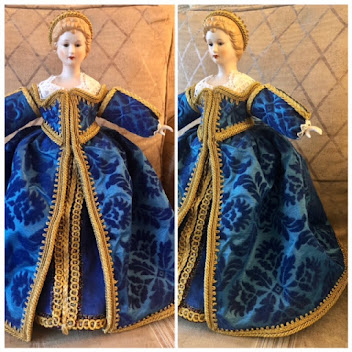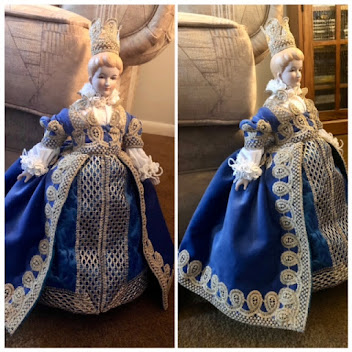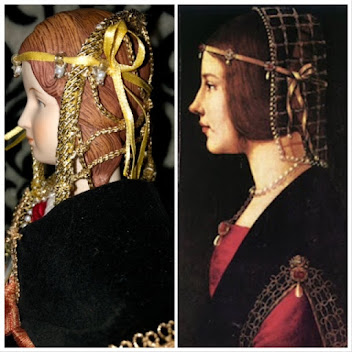| Embroidered Appliqués |
I started with a linen base on my pocket which was made with a running stitch. The shape of a pocket traditionally is pear shaped. Mine is shield shaped, compared to the traditional. I wanted to go with something that had a longer top edge so I have an easier time putting a drawstring it though the top to be reinforced better. Though plans changed in the end on the strings. If I was sewing two corners, I wanted to really give it a little extra support in the pattern.
| Linen base pocket |
I had made the original linen sometime ago and had not picked it up to do needlework, was going to make blackwork this originally. original in linen sometime ago. After having done some research even despite the pattern being a little bit different for my pocket. I will still wanted to use the linen that I already had. So I went to look and see if there was different types of materials I could use for the outside. And I found the documentation on Italian Soccici.
Basically there wasn't any English version of these pockets until the 17th century. So the Italians were using a decorated pocket for ladieswear in the 16th century. I was basing my pocket on the extent example still exist, as well as a reference to a Italian fresco that shows a lady laundering items and has one of these pockets while she works.
| Assembled Pocket with Embroidered Appliqués |
After I studied the period examples, I looked at my stock of fabrics and chose the following materials; orange gold silk fabric and coral velvet fabric. I had embroidery that I made on silk chiffon blend fabric and appliquéd it to the surface of my orange silk. Then I used the same unplied filament silk embroidery thread and made a border of floral accent in orange with a green herringbone stitch, where the velvet met the silk fabric. Then added pearls to the edges blending some into look like buds in the design.
The embroidery pattern is based from the painting of the Marchioness of Northampton; Helena Snakenborg circa 1569. This is the embroidery pattern that you see on her shirt in the painting, I enlarged it to look at the pattern. The arrangement of the roses depicted is what I used as the basis of my embroidery pattern. It's an unplied filament silk embroidery on silk chiffon backing with fresh water pearl accents then appliquéd to the pocket.
| Added Appliqués and Pearls |
| Completed Pocket |
What project would not be complete without pictures. I'm including that various
different photos showing the progress that I had made despite working the weekend. Now to get the rest of it documented properly on paper plus get the documentation done for the ruff and cuff suite as well as the gold work and pearled French Partlet.
Well that is it for now, I must get back to the mundane. I will be lining and adding the tie strings to my French partlet.
Until next time,
Mairin





No comments:
Post a Comment